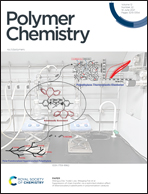Precise synthesis of linear polysiloxanes with a polar side-chain structure by organocatalytic controlled/living ring-opening polymerization of (3-cyanopropyl)pentamethylcyclotrisiloxane†
Abstract
The organocatalytic controlled/living ring-opening polymerization (ROP) of (3-cyanopropyl)pentamethylcyclotrisiloxane (CNPD2) using water or a silanol as the initiator, 1,3-trimethylene-2-methylguanidine (TMMG) as the catalyst, and organochlorosilanes as the end-capping agents produced linear polysiloxanes with a controlled number-average molecular weight (Mn), narrow molecular-weight dispersity (ĐM), the desired terminal structures, and good distribution of the 3-cyanopropyl side-chains. CNPD2 was obtained from the reaction of 1,3-dihydroxy-1,1,3,3-tetramethyldisiloxane with diacetoxy(3-cyanopropyl)methylsilane. The composition and monomeric sequence of the resulting side-chain-functionalized polysiloxanes were conveniently controlled by using either polymerization of CNPD2 or copolymerization of CNPD2 and another cyclotrisiloxanes and by varying the initial feed ratio of the two monomers and the monomer addition timing, i.e., using either premix or two-stage methods in the copolymerizations. An analysis of the monomeric sequences using 29Si{1H} NMR measurements revealed that the polymerizations proceeded almost completely in the statistical propagation mode. Plausible monomeric sequences and chain-length distributions of the resulting side-chain-functionalized polysiloxanes were visualized using two simulation methods. The solubility and thermal properties of the resulting polysiloxanes with cyanopropyl group side chains were investigated. Importantly, the poly[dimethylsiloxane-co-3-cyanopropyl(methyl)siloxane] (p(DMS-co-CNPMS)) segments behave independently in the copolymer synthesized from hexamethylcyclotrisiloxane and CNPD2 using the two-stage method.



 Please wait while we load your content...
Please wait while we load your content...